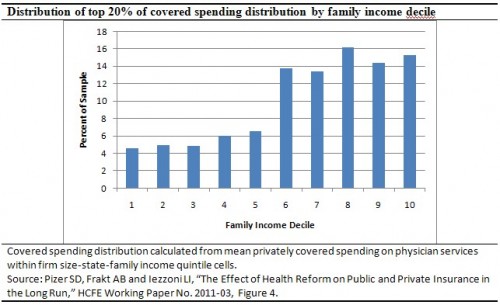In some recent posts (one, two, three) I’ve been discussing how the Cadillac tax provision of PPACA can be expected to shift some workers from private insurance to public insurance. This is the topic of my recent working paper with Austin and Lisa Iezzoni. One question raised by our results is: how can the Cadillac tax, which is aimed at high-premium health plans, affect public insurance enrollment, which is limited to low-income individuals? Isn’t it true that those covered by high-premium health insurance are high-income workers?
This turns out to be a difficult question to answer empirically because most surveys collect data either from households or from firms, not from both. The few that we know of that link workers to firms are not available to researchers outside of the Census Bureau.
We used the Medical Expenditure Panel Survey, which is a household survey that doesn’t have premium information but collects data on health care spending and insurance coverage. We tabulated privately covered spending on physician services by firm size-state-family income quintile cells to approximate the distribution of premiums. We assumed that physician spending is proportional to total health care costs and that total costs are proportional to insurance premiums (spending on hospital services is very noisy, reflecting variation in health more than variation in coverage). The results for the top 20% of the spending distribution (those expected to be affected by the tax in 2018) are illustrated below.

These results suggest that firms paying high health insurance premiums may be as much as four times more likely to employ high-wage workers than low-wage workers. Nevertheless, substantial numbers of low-wage workers are employed by these firms and it is these low-wage workers who are most likely to shift from private to public insurance in response to the Cadillac tax.

